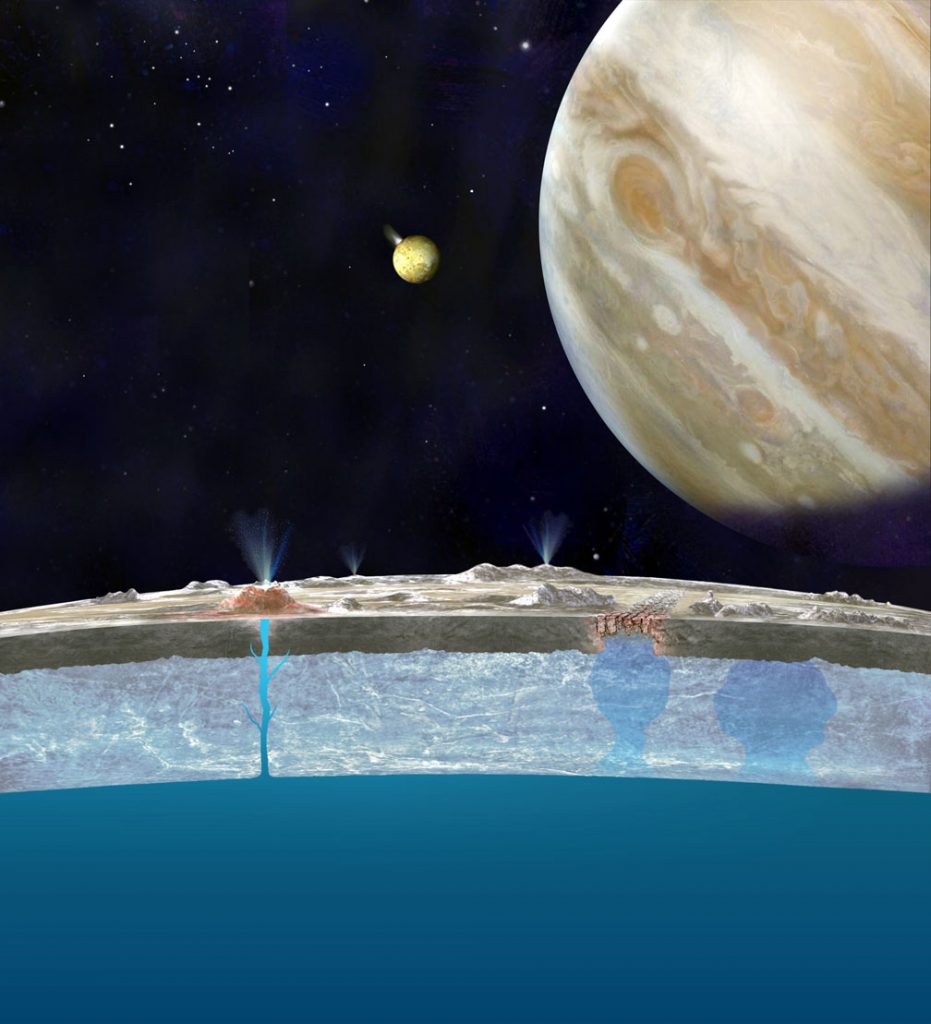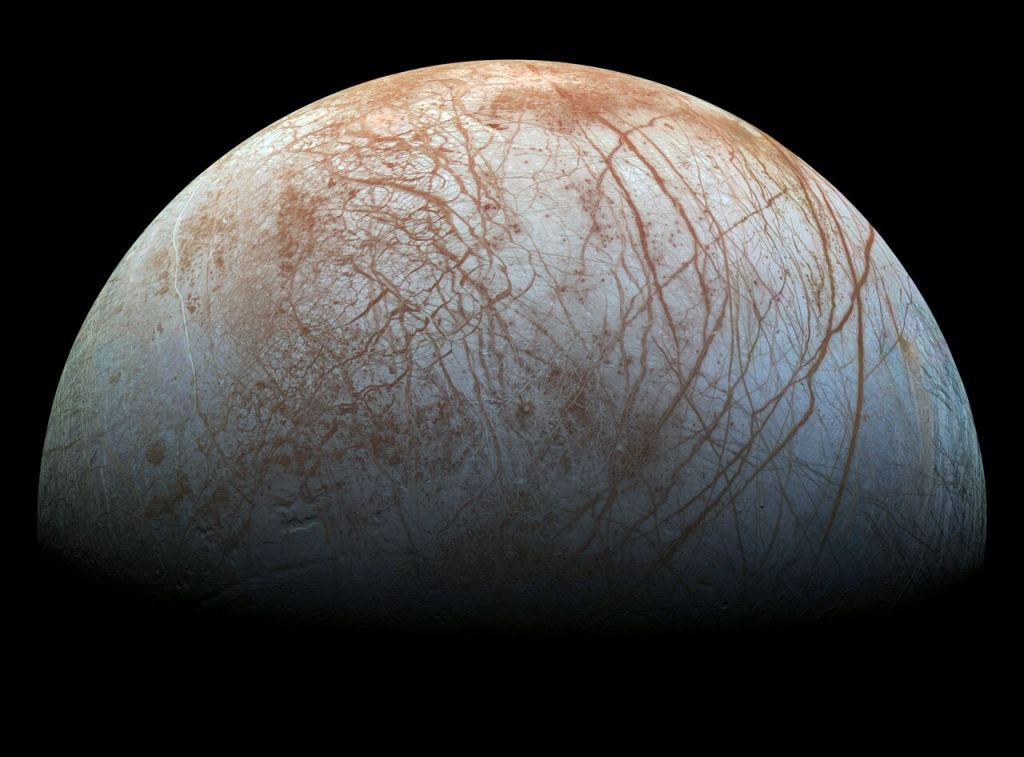Europa has Water in its Atmosphere
Since the Voyager probes passed through the Jupiter system in 1979, scientists have been intrigued and mystified by its moon Europa. Once the images these probes acquired of the moon’s icy surface returned to Earth, scientists began to speculate about the possibility of a subsurface ocean. Since then, the detection of plume activity and other lines of evidence have bolstered this theory and fed speculation that there could be life beneath Europa’s icy surface.
According to new research, another critical piece of evidence of Europa’s watery nature has at least been confirmed. Using a similar technique that confirmed the presence of atmospheric water vapor in Jupiter’s moon Ganymede, Lorenz Roth of the KTH Royal Institute of Technology confirmed that Europa has water vapor in its atmosphere. This discovery could lead to a greater understanding of Europa’s atmosphere and surface environment, informing missions headed there in the near future.
As one of the larger Jovian moons that Galileo discovered in 1610 (hence why they are also known as the “Galilean Moons”), Europa is one of several bodies in the Solar System believed to have interior oceans. This has led scientists to designate them as “Ocean Worlds,” which many astrobiologists consider the most likely place to find evidence of extraterrestrial life.

For the sake of this study, Roth (a researcher with the KTH in Stockholm) consulted archival data acquired by Hubble’s Space Telescope Imaging Spectrograph (STIS). Specifically, he looked at ultraviolet observations made of Europa in 1999, 2021, 2014, and 2015, when the Moon was in various orbital positions. These observations allowed Roth to determine the abundance of molecular oxygen (O2) in the sunlit portion of Europa’s atmosphere.
Since Europa is tidally-locked with Jupiter (like the Moon is with Earth), one hemisphere permanently faces Jupiter while the other is always facing the direction opposite Europa’s orbital path. After examining the strength of the O2 emissions at different wavelengths, and the way these were persistent from 1999 to 2015, Roth inferred the readings were due to a stable abundance of water vapor in Europa’s trailing hemisphere.
As Roth explained in an ESA Hubble press release, previous studies based on computer simulations predicted the asymmetric distribution of water vapor but never confirmed. “The observation of water vapor on Ganymede and the trailing side of Europa advances our understanding of the atmospheres of icy moons,” he said. “The detection of a stable H2O abundance on Europa is surprising because the surface temperatures are so low.”
Previously, the detection of water vapor on Europa had been associated with transient plumes observed erupting through the ice, which can reach up to 100 km (62 mi) above the surface. Roth’s results, however, showed that a similar amount of water vapor was spread over a larger area throughout the observation period. This suggests the long-term presence of water in Europa’s trailing hemisphere, but not in the leading hemisphere.

The emissions detected by Hubble suggest that the ratio of water to molecular oxygen (H2O/O2) in Europa’s trailing hemisphere is about 12 to 22. The emissions also indicate that the atmosphere is composed of pure O2 across the entire leading hemisphere. These results will not only help astronomers to characterize the Jovian Moon’s atmosphere but will also inform the missions that are destined for Europa before the end of this decade. Said Roth:
“This result lays the groundwork for future science based on upcoming missions to the Jovian moons. The more we can understand about these icy moons before spacecraft like JUICE and Europa Clipper arrive, the better use we can make of our limited observing time within the Jovian system.”
At present, three missions are in development that will explore Europa’s surface and search for “biosignatures” (potential signs of life). These include the ESA’s JUpiter ICy moon Explorer (JUICE), an orbiter scheduled to launch next year and arrive in the Jovian system by 2032. This mission is primarily dedicated to studying Ganymede’s atmosphere, surface, and structure but will also conduct two flybys of Europa to obtain data on its surface features and composition.
Then there’s the NASA Europa Clipper mission, which has a planned launch date of 2024 and will rendezvous with Europa by 2030. This orbiter will study the planet’s surface with spectrometers, thermal imaging, radar, a magnetometer, and other instruments to learn about its composition and interior structure. It will also scope out potential landing sites for a potential Europa Lander mission, which would continue to search for possible biosignatures from the surface.

With the help of research like Roth’s, the data and insights provided by these missions will address some of the most profound questions we have regarding life in the Universe. For example, is life most likely to exist on rocky planets (a la Earth and Mars), or in “Ocean Worlds” that orbit gas giants? They will also benefit from observations made by next-generation observatories like the James Webb Space Telescope (JWST), a joint NASA-ESA-CSA mission scheduled to launch in just a few weeks.
The Nancy Grace Roman Space Telescope (RST) and ground-based observatories will join Webb before the decade is over and use their cutting-edge instruments and optics to characterize the exoplanet atmospheres and climates. These studies will have significant implications, and not just for our understanding of the kinds of potentially habitable environments that exist in our Solar System. They will also help with the search for life in other star systems, which could also be locked away beneath the icy surfaces of exomoons.
Further Reading: ESA Hubble, Geophysical Research Letters
The post Europa has Water in its Atmosphere appeared first on Universe Today.
Universe Today
Go to Source